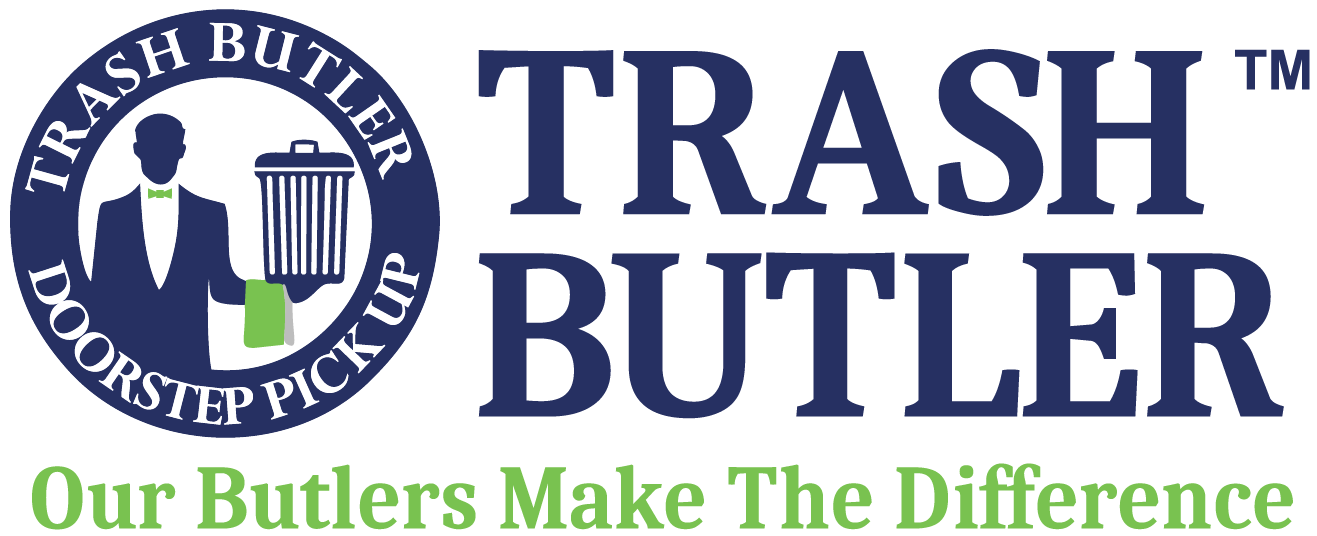Key Takeaways:
- Understanding Recycling Symbols: Recycling symbols on packaging play a vital role in guiding consumers and recycling facilities in the proper sorting and processing of materials.
- Technological Innovations: The recycling industry benefits significantly from technological advancements, such as AI-driven sorting systems and new processing techniques for difficult-to-recycle materials.
- Community Engagement And Education: Individual actions, supported by community initiatives and education about proper recycling with Trash Butler, can lead to significant environmental benefits.
Plastic recycling symbols, also known as resin codes or SPI codes, are crucial indicators to help consumers and businesses understand how to properly recycle different types of plastics. These symbols are typically found on the bottom of plastic containers, bottles, and packaging. By familiarizing yourself with these symbols, you can contribute to more sustainable and environmentally friendly recycling.
1. PET Or PETE (Polyethylene Terephthalate)
Symbol 1 indicates that the plastic container is made of PET. This is commonly used for water bottles and food packaging. These containers are widely accepted for recycling.
2. HDPE (High-Density Polyethylene)
Symbol 2 signifies HDPE plastic. This is commonly found in milk jugs, detergent bottles, and some plastic bags. HDPE is one of the easiest plastics to recycle.
3. PVC (Polyvinyl Chloride)
Symbol 3 indicates PVC plastic. It is often used in pipes, flooring, and medical equipment. PVC is not often recycled and should be kept separate from other plastics.
4. LDPE (Low-Density Polyethylene)
Symbol 4 represents LDPE plastic. It is used in items like shopping bags, squeezable bottles, and food wraps. LDPE is recyclable but may not be accepted in all recycling programs.
5. PP (Polypropylene)
Symbol 5 denotes PP plastic. This is used in yogurt containers, ketchup bottles, and medicine bottles. PP is widely recyclable but check with your local recycling facility.
Understanding PET Or PETE (Polyethylene Terephthalate)
Recyclability Of PET
PET is highly recyclable. It can be used to create new products such as clothing fibers, carpeting, and packaging. Different grades of PET may impact recyclability, so it’s important to follow local recycling guidelines.
Recycling Guidelines For PET
To ensure proper recycling of PET products, follow local recycling guidelines. Separate PET from other plastics. Rinse PET containers before recycling to prevent contamination.
Contamination Concerns
Avoid mixing PET with other plastics during recycling. This can reduce the quality of the recycled material. Proper sorting and adherence to recycling guidelines are important for maintaining recycling efficiency.
Promoting Sustainability Through PET Recycling
Understanding the PET recycling process is crucial for reducing plastic waste. It helps promote sustainability. By correctly interpreting PET recycling symbols and following recycling guidelines, consumers can contribute to a more eco-friendly future.
Understanding HDPE (High-Density Polyethylene)
Benefits Of HDPE
HDPE is known for its durability and strength, making it a popular choice for packaging materials. It is also one of the easiest types of plastic to recycle. When you see the HDPE symbol, which consists of the number 2 inside the recycling symbol, it indicates that the item is made from High-Density Polyethylene and can be recycled.
Environmental Impact
Recycling HDPE is beneficial for the environment. It reduces the amount of plastic waste that ends up in landfills or oceans. The process of recycling HDPE involves sorting and cleaning the plastic, melting it down, and then shaping it into new products.
Taking Action
Next time you see the HDPE recycling symbol, remember that by recycling these items, you are contributing to a more sustainable future. Check with your local recycling facilities to ensure you are disposing of HDPE plastics correctly. Together, we can make a difference by choosing to recycle and reduce our impact on the environment.
The Versatile World Of PVC
Concerns With PVC
Despite its versatility, PVC poses environmental and health concerns. The production process releases toxic chemicals like dioxins and phthalates, contributing to pollution and health risks. Moreover, PVC is non-biodegradable and can persist in the environment for extended periods, adding to plastic pollution.
Challenges In Recycling PVC
PVC is not easily recyclable due to its chemical composition and additives like plasticizers. These additives complicate the recycling process. They hinder the quality of the recycled material, leading to low recycling rates compared to other plastics.
Sustainable Solutions
To address PVC concerns, it is vital to prioritize sustainable practices. This includes reducing PVC consumption, opting for recyclable materials, and supporting eco-friendly alternatives. This works towards a healthier and more sustainable future.
Understanding LDPE (Low-Density Polyethylene)
Recycling LDPE
When LDPE is recycled, it can be turned into new products such as plastic lumber, garbage can liners, and floor tiles. The recycling process for LDPE involves collecting and sorting the plastic, cleaning and shredding it into small pieces, melting these pieces down, and then reforming them into new products. This helps to reduce the amount of LDPE waste in landfills and contributes to a more sustainable environment.
Challenges And Solutions
One challenge with recycling LDPE is that not all recycling facilities accept this type of plastic. It is important to check with your local recycling program to see if they can process LDPE items. If not, some grocery stores and retailers offer recycling programs for plastic bags and films made from LDPE.
Making A Positive Impact
By understanding the recycling symbol for LDPE and knowing how to properly dispose of this type of plastic, you can make a positive impact on the environment. Consider reducing your use of LDPE products or finding ways to recycle them responsibly. This can help create a more sustainable future.
The Versatility Of PP (Polypropylene) In Various Industries
Food Packaging Industry
One common use of PP is in the food packaging industry. PP containers and packaging are commonly used due to their heat resistance and good sealing properties. PP’s ability to withstand high temperatures without leaching harmful chemicals makes it a safe choice for storing food and beverages.
Automotive Industry
Another prevalent application of PP is in the automotive industry. PP can be found in car bumpers, interior trim, and battery cases due to its impact resistance and durability. The lightweight nature of PP also helps improve fuel efficiency in vehicles.
Healthcare Sector
In the healthcare sector, PP is widely used for the production of medical devices and equipment. Its ability to be sterilized makes it a suitable choice for items like syringes, vials, and IV bottles. PP’s chemical resistance ensures that these medical supplies remain safe and intact during their intended use.
Textile Industry
Additionally, PP is used in the textile industry. It’s used in the production of carpets, ropes, and thermal clothing. Its moisture-wicking properties and resistance to mold and mildew make it an ideal material for outdoor and sports apparel.
PS (Polystyrene) And Its Environmental Impact
Overview Of Polystyrene
Polystyrene, identified by the recycling symbol 6, is a widely used plastic material known for its lightweight and insulating properties. However, polystyrene is not easily recyclable. It often ends up in landfills or the environment, where it can take hundreds of years to decompose.
Environmental Concerns
The production and disposal of polystyrene can have a significant negative impact on the environment. It contributes to pollution and harming wildlife. To minimize the environmental impact of polystyrene, it’s best to reduce the use of polystyrene products. Opt for more sustainable alternatives whenever possible.
Unveiling The 7th Plastic Category
While the majority of plastic products fall under the familiar six recycling symbol categories, there is also a relatively new addition to the plastic recycling family: the 7th category. This category, represented by a three-arrow recycling symbol around the number 7, is specifically designated for miscellaneous plastics. These do not fit into the traditional categories of #1 to #6.
Diverse Uses Of #7 Plastics
The #7 plastics are used for various purposes, including durable goods, electronic equipment, and certain types of food containers. However, the challenge with these miscellaneous plastics is that they can be made from a wide range of materials. This makes the recycling process more complex.
Example: Polycarbonate Plastics
One common type of #7 plastic is polycarbonate. This is often used in items such as baby bottles, water cooler bottles, and compact discs. While some facilities are equipped to handle the recycling of #7 plastics, not all recycling centers are able to process these materials effectively.
Recycling Guidelines And Future Sustainability
It is essential for consumers to check with their local recycling programs to see if they accept #7 plastics and to follow any specific guidelines for preparing these items for recycling. Additionally, some manufacturers are working towards developing more sustainable alternatives to #7 plastics. This can reduce environmental impact and make recycling easier.
Final Thoughts
Understanding plastic recycling symbols is essential for a greener future. By knowing these symbols and sorting plastic waste correctly, we can reduce pollution. Each symbol indicates if an item is recyclable and how to process it.
By following these guidelines and spreading awareness, we can all contribute to a cleaner environment. Let’s make informed choices and work together towards a sustainable world where resources are reused efficiently. Request a quote today!
Frequently Asked Questions
What do the numbers inside the recycling symbols on plastics mean?
The numbers inside the recycling symbols on plastics, ranging from 1 to 7, represent the type of plastic used in the product. This coding system is known as the Resin Identification Code (RIC) and is used to aid in sorting and recycling processes.
How can I tell if a plastic item is recyclable in my area?
To determine if a plastic item is recyclable in your area, you should check with your local recycling program. Recycling capabilities can vary significantly from one municipality to another. Most programs will provide guidelines on which types of plastics they accept.
What does the number 1 inside the recycling symbol indicate?
The number 1 inside the recycling symbol denotes PET or PETE (Polyethylene Terephthalate), commonly used for disposable bottles and containers. It is widely accepted in recycling programs.
Is plastic marked with number 2 considered safe for food storage?
Yes, plastics marked with number 2 indicate HDPE (High-Density Polyethylene), which is considered safe for food storage. It has a high resistance to chemicals and moisture.
Can plastics labeled with number 3 be recycled?
Plastics labeled with number 3 represent PVC (Polyvinyl Chloride), which is less commonly accepted in curbside recycling programs due to its chlorine content and potential release of harmful chemicals during the recycling process.
Why are plastics marked with number 4 often found in grocery bags?
Plastics marked with number 4 indicate LDPE (Low-Density Polyethylene). This material is flexible and durable, making it ideal for shopping bags, squeeze bottles, and cling wraps. However, recycling facilities for LDPE bags and wraps are less common, though they are often collected at grocery stores for recycling.
What does the recycling symbol with a 5 mean?
The recycling symbol with a 5 represents PP (Polypropylene), a type of plastic found in yogurt containers, ketchup bottles, and medicine bottles. It is heat-resistant and recyclable, though not all recycling programs may accept it.
Are plastics with the number 6 recyclable?
Plastics with the number 6 denote PS (Polystyrene), also known as styrofoam. While technically recyclable, its recycling is limited due to cost and environmental impact concerns. Many recycling programs do not accept it.
What kind of plastic is identified by the number 7 in the recycling symbol?
The number 7 in the recycling symbol represents other types of plastics that do not fit into categories 1 through 6, including bioplastics, polycarbonate, and acrylic. Recycling of No. 7 plastics is rare and dependent on the specific material composition.
How does the recycling number affect the recyclability of plastic?
The recycling number affects the recyclability of plastic by indicating its composition, which in turn determines the recycling process it can undergo. Not all types of plastics are accepted by all recycling programs, and the number provides a guide on how and where the plastic can be recycled





